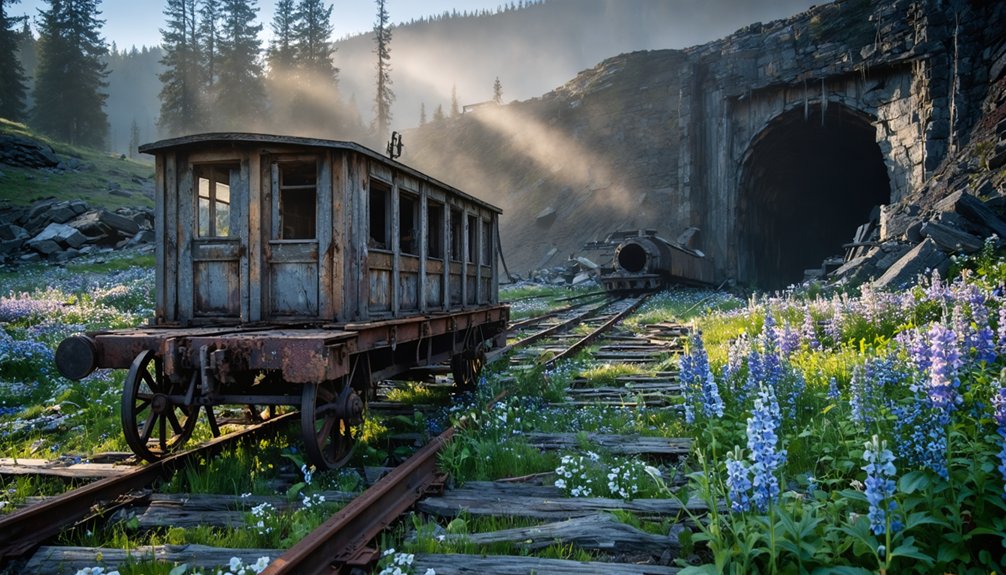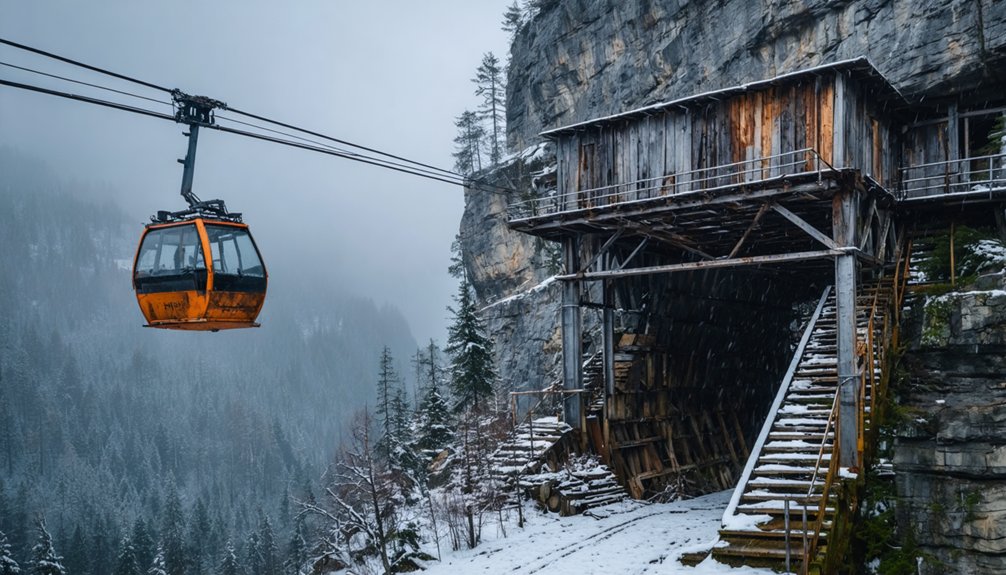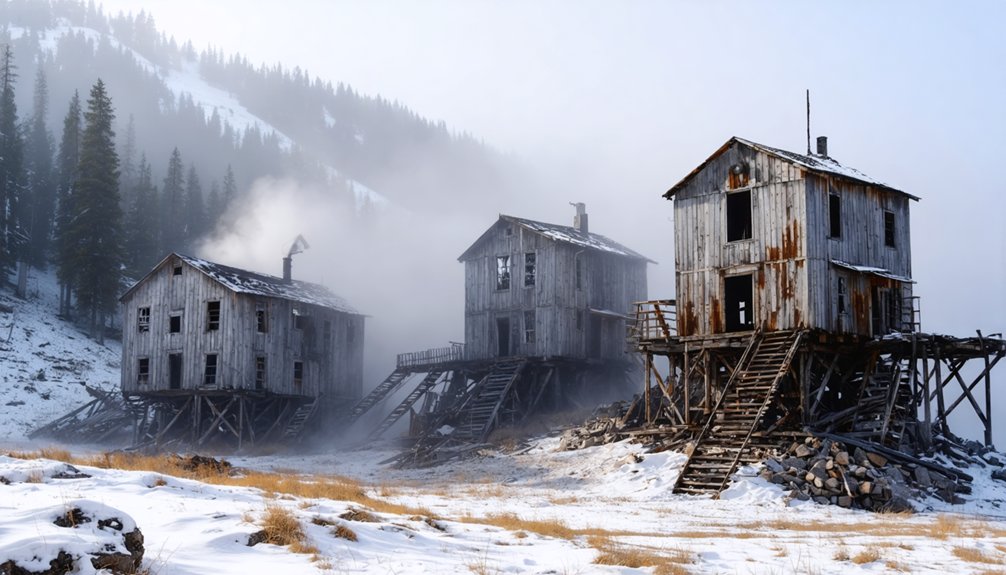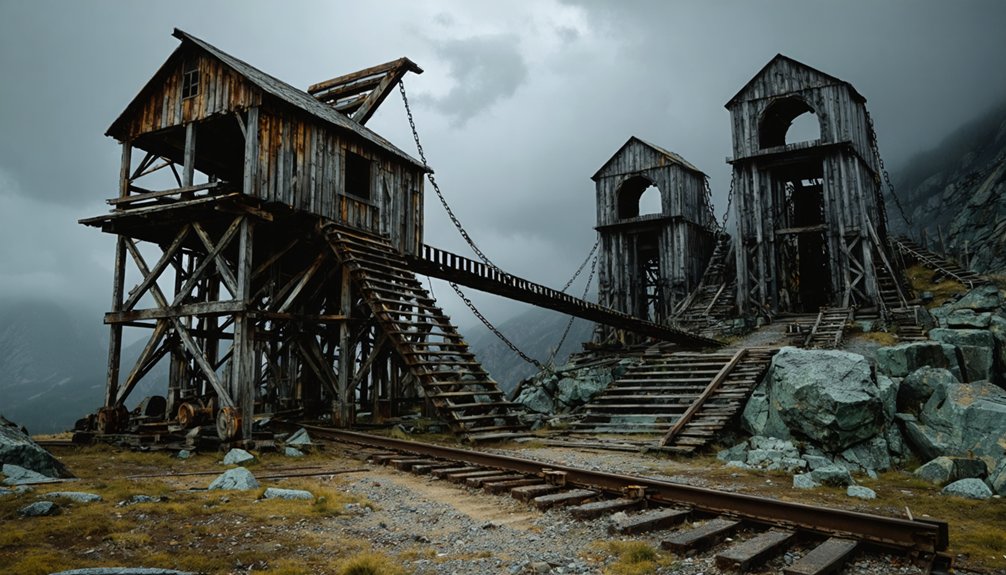Colorado’s mining past lingers in over 1,500 ghost towns where wooden structures stand frozen in time. You’ll find eerie underground labyrinths like the Argo Tunnel honeycomb the mountains, while acid mine drainage continues to poison streams with toxic metals. Rusting equipment dots the landscape as silent witnesses to industrial ambitions. Even the folklore persists—tales of tommyknockers, spirits who warned miners of impending danger, still haunt these abandoned sites today.
Key Takeaways
- Colorado has over 1,500 ghost towns, with 640 having visible remains serving as eerie monuments to boom-and-bust mining cycles.
- Abandoned mining tunnels create vast underground labyrinths beneath Colorado’s mountains, including the historic Argo Tunnel.
- Acid Mine Drainage has created toxic waters with harmful heavy metals, affecting nearly 1,800 miles of Colorado’s streams.
- Rusting machinery and deteriorating industrial equipment stand as haunting relics throughout former mining sites.
- Tommyknocker legends from Cornish immigrants persist in mining folklore, with tales of mysterious knocking sounds warning of cave-ins.
Ghost Towns: Silent Monuments to Boom and Bust

While Colorado’s mountains now attract tourists and outdoor enthusiasts, they once drew thousands of ambitious miners seeking their fortunes in gold and silver.
Today, over 1,500 ghost towns dot the landscape—640 with visible remains—each telling stories of spectacular booms and devastating busts.
You’ll find places like St. Elmo, where well-preserved wooden structures stand as evidence of a community that once housed 2,000 souls.
Or Ashcroft, which briefly outpaced Aspen before rapidly declining when its gold played out.
These ghost town experiences offer glimpses into an era when fortunes changed overnight.
Independence, named for its discovery on July 4, 1879, produced gold worth over $190,000 in just two years before miners eventually abandoned it for nearby Aspen.
Colorado’s mining heritage lives on through these silent monuments, where towns like Goldfield and Henson demonstrate how quickly prosperity could vanish when ore quality dropped or economic conditions shifted.
Much like what happened in other states, many of these abandoned communities suffered decline due to the depletion of resources that had originally drawn settlers to these remote locations.
The Haunting Remains of Underground Labyrinths
Beneath Colorado’s rugged mountains lies a hidden world of abandoned mining tunnels—intricate labyrinths that once served as the lifeblood of the state’s mineral economy.
You’ll find engineering marvels like the 4.2-mile Argo Tunnel, built in 1910 to drain floodwaters and later transport ore directly to processing facilities.
These complex networks solved critical water management challenges, allowing miners to reach deeper veins while addressing acid drainage problems. The tunnel helped mining companies dig deeper with better flood prevention, a primary purpose when it was constructed.
The Treasury Tunnel and Idarado Mine’s 5-mile passage beneath 13,000-foot mountains represent remarkable achievements in tunnel exploration.
Today, these underground corridors stand silent yet significant.
The Argo Mill, once processing 300 tons daily, now serves as a museum—while its tunnel, rehabilitated in the 1990s, channels polluted water to treatment facilities, transforming what was once purely extractive infrastructure into an environmental solution. The Edgar Mine offers visitors a glimpse into mining history as an underground classroom for students and tourists alike.
Environmental Scars: Toxic Waters and Tainted Landscapes

Long after the mining booms subsided, Colorado’s landscape bears the toxic legacy of its extraction history through a troubling phenomenon called Acid Mine Drainage (AMD).
You’ll find over 23,000 abandoned mines across the state, with nearly 1,800 miles of streams impaired by metals and acidity. When oxygen and water react with exposed sulfide minerals, they create highly acidic runoff loaded with cadmium, zinc, and lead.
These contaminants don’t just stay put. They bioaccumulate in food chains, spread through windblown dust from tailings piles, and permanently scar watersheds like the Animas River basin. Mining operations release harmful heavy metals into the environment that can contaminate agricultural products and nearby water sources. The Colorado Geological Survey has published numerous detailed studies documenting these environmental impacts across the state.
Environmental restoration efforts face massive challenges, as heavy metals persist in soils for centuries, complicating reclamation and threatening both ecosystems and human health.
Abandoned Equipment: Rusting Relics of Industrial Dreams
The rusting behemoths of Colorado’s mining era stand as silent sentinels across mountain landscapes, telling stories that toxic waters cannot.
You’ll find these industrial ghosts everywhere from Nevadaville to Crystal City—ore stamps that once crushed rock with rhythmic precision, dangerous overshot muckers aptly nicknamed “widow makers,” and towering headframes marking entrances to subterranean worlds.
In Gunnison Valley and Cripple Creek, deteriorating rail grades and equipment preservation efforts offer glimpses into engineering ingenuity. The historic Gronk structure at Peanut Lake stands as a testament to the valley’s coal mining history. Recent explorations have uncovered large, unexpected structures hidden in valleys throughout the historic mining districts.
The Charlie Taylor Water Wheel in Idaho Springs represents one of few restored pieces, while most industrial design marvels rot where they stand.
Each site presents both historical treasure and physical hazard—unstable structures and sharp edges reminding you that these abandoned tools weren’t built for safety but for efficiency in a time when production outweighed precaution.
Folklore and Legends of Colorado’s Mining Shadows

While descending into the darkened tunnels of Colorado’s historic mines, you’ll encounter more than just physical remnants—an entire supernatural ecosystem exists in mining folklore.
Tommyknocker tales, brought by Cornish immigrants during the 1820s gold rushes, permeated Colorado’s mining culture from Central City to Leadville. These diminutive, gnome-like spirits evolved from malicious territorial beings to protective allies who warned of impending cave-ins through mysterious knocking sounds.
Miner superstitions included leaving the last bite of pasties as offerings and attributing blue orbs of light to the creatures’ guidance toward rich ore deposits. Miners placed ceramic figures of tommyknockers at mine entrances as a constant reminder to proceed with caution.
The folklore transcended ethnic boundaries and persists today in Colorado’s heritage, evident in Idaho Springs’ Tommyknocker Brewery and Georgetown’s Capital Prize Mine Tours—enduring elements of the state’s evolution from industrial mining to cultural tourism. These stories continue to fascinate visitors who explore over 600 ghost towns scattered throughout Colorado’s rugged landscape.
Frequently Asked Questions
Can Visitors Legally Collect Artifacts From Abandoned Colorado Mining Sites?
No, you can’t legally collect artifacts from abandoned mining sites. Artifact ownership is governed by strict legal regulations prohibiting removal from public lands while private property requires explicit landowner permission.
What Safety Precautions Should Explorers Take When Visiting Old Mining Areas?
After Reno collapsed at an unmarked mine entrance, it’s clear: only visit designated tourist mines with proper safety gear and maintain terrain awareness. Never enter abandoned mines—they’re illegal deathtraps with unstable structures.
Which Mining Ghost Towns Offer Guided Tours or Historical Demonstrations?
You’ll find guided ghost tours in Ouray’s Red Mountain District, Vail’s Fulford and Gilman towns, and historical reenactments at Central City’s Gilpin Museum, Mollie Kathleen Mine, and Country Boy Mine near Breckenridge.
How Have Modern Mining Companies Repurposed Historical Mining Infrastructure?
Over 40% of mining companies now practice adaptive reuse, converting historical headframes into visitor centers, transforming mill buildings for hospitality, and repurposing tailings through sustainable practices like CJK Milling’s profitable gold extraction operations.
What Preservation Efforts Protect Colorado’s Mining Heritage From Disappearing Completely?
You’ll find Colorado’s mining heritage protected through National Register listings, State Historical Fund grants, local landmark designations, and conservation easements—all preserving historical significance while balancing heritage conservation with environmental concerns and community needs.
References
- https://www.uncovercolorado.com/colorado-mining-history-timeline/
- https://en.wikipedia.org/wiki/Timeline_of_mining_in_Colorado
- https://www.denvergazette.com/2022/06/19/starting-in-1858-heres-a-look-at-the-timeline-of-colorados-mining-past-20bc26e4-e4d3-5eae-8520-8fa197554111/
- https://westernmininghistory.com/4785/the-colorado-gold-rush/
- https://archives.colorado.gov/collections/historic-mine-reports
- https://coloradogeologicalsurvey.org/minerals/historic-mining-districts/
- https://www.mininghistoryassociation.org/Journal/MHJ-v3-1996-Stene.pdf
- https://www.hcn.org/issues/48-7/a-gold-king-mine-timeline/
- https://www.geotab.com/ghost-towns/
- https://www.denver7.com/news/local-news/colorado-ghost-towns-their-past-present-and-future-in-the-rocky-mountains



